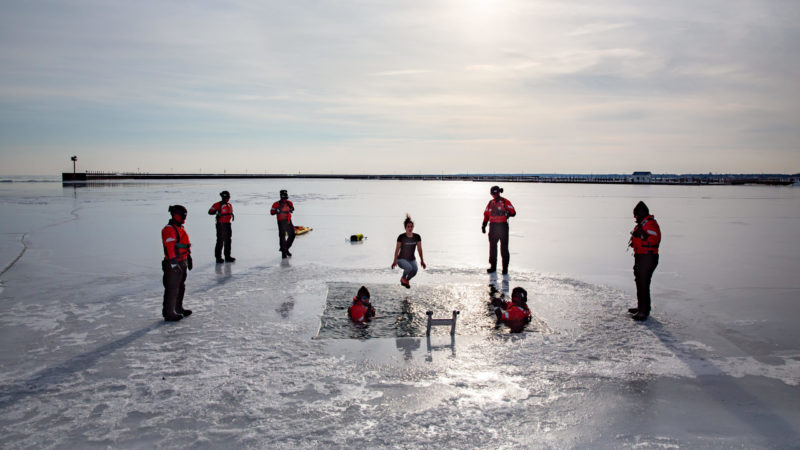The expanding ice has its own language. It sounds like a sea creature, warbling and reverberating with an otherworldly howl. The first time I heard it in 2017, I thought, Oh no, this is it; I checked my feet to make sure I was still standing on something. “Ice earthquake,” a nearby angler said to me when he saw the fear flickering in my eyes. Seconds later he was back to jigging his line. He was already fluent in the language of the ice. I was just learning it.
For six years, I’ve been photographing the Great Lakes’ ice, or what’s left of it. As of February 15, 2023, ice coverage across all five of the Great Lakes was at 6.6 percent, the lowest since satellite records began in 1973. Some years I’ve had to drive hundreds of miles across Michigan just to find it. I scan the water’s edge for ice fingers extending to the horizon.
Some of my earliest memories are of my father, a fifty-year Michigan ice fisherman, leaving the house in the muddy black of winter mornings, armed with a bucket, spud, and ice auger, and a desire to catch the limit before sunrise. Sometimes he would sit for hours on a down-turned white bucket just to snag a single palm-sized perch. I remember December afternoons when he would fry up his catch for the family, the house filling with scents and sounds that signaled he’d had a productive morning.
But those days don’t happen as much as they used to. “I can’t remember the last time I was able to ice-fish before Christmas,” he says to me almost every year come winter.
Now I drive the lakes’ edges and search for those who know the ice as well as my dad does. I’ve sat with countless Midwestern anglers like my father, peering for hours into eight-inch holes chiseled into the ice, waiting for fish to come. I’ve documented winter ice festivals, snowmobile drag races, broom ice hockey matches, and ice boat meetups. I’ve met kids who glide across the lake on hand-me-down skates their parents used when the ice was reliable. I’ve seen a man soaring above the ice in a flying go-cart, pedaling into the air, wild with excitement.
I’ve photographed countless crazy Michiganders, like the woman in the picture above, who plunge through the ice just for fun. For the past five years, I’ve driven up from my home in Detroit to photograph the plunge at Perchville, a festival in Tawas, Michigan. Many plungers participate year after year after year. The tradition, less about what they do and more about who they are, is the culture they inhabit.
Some years fans gather on the ice to hoot and holler at their favorite plungers. This year, we’re asked to watch from the shore. The ice is so thin, it can’t support a crowd. A few years back there was no ice. Participants ran into the water from the beach. It looked like summer.
Like countless other winter enthusiasts in Michigan, I watch the weather intently for signs of warming and melting conditions. I look at the statistics; I think of my father peering out on the lake’s expanse in winter. Will it or will it not? I think of his heavy winter fishing boots unlaced on the hardwood floor, his bright orange camouflage snowsuit hanging in the garage. I cross my fingers for more ice, any ice, and rarely see signs of it.
The cultural fabric of Michigan is knitted together by single-digit temperatures, all of us shivering to the bone together. We don’t need to talk much, because the ice speaks for us. What happens when it melts?

